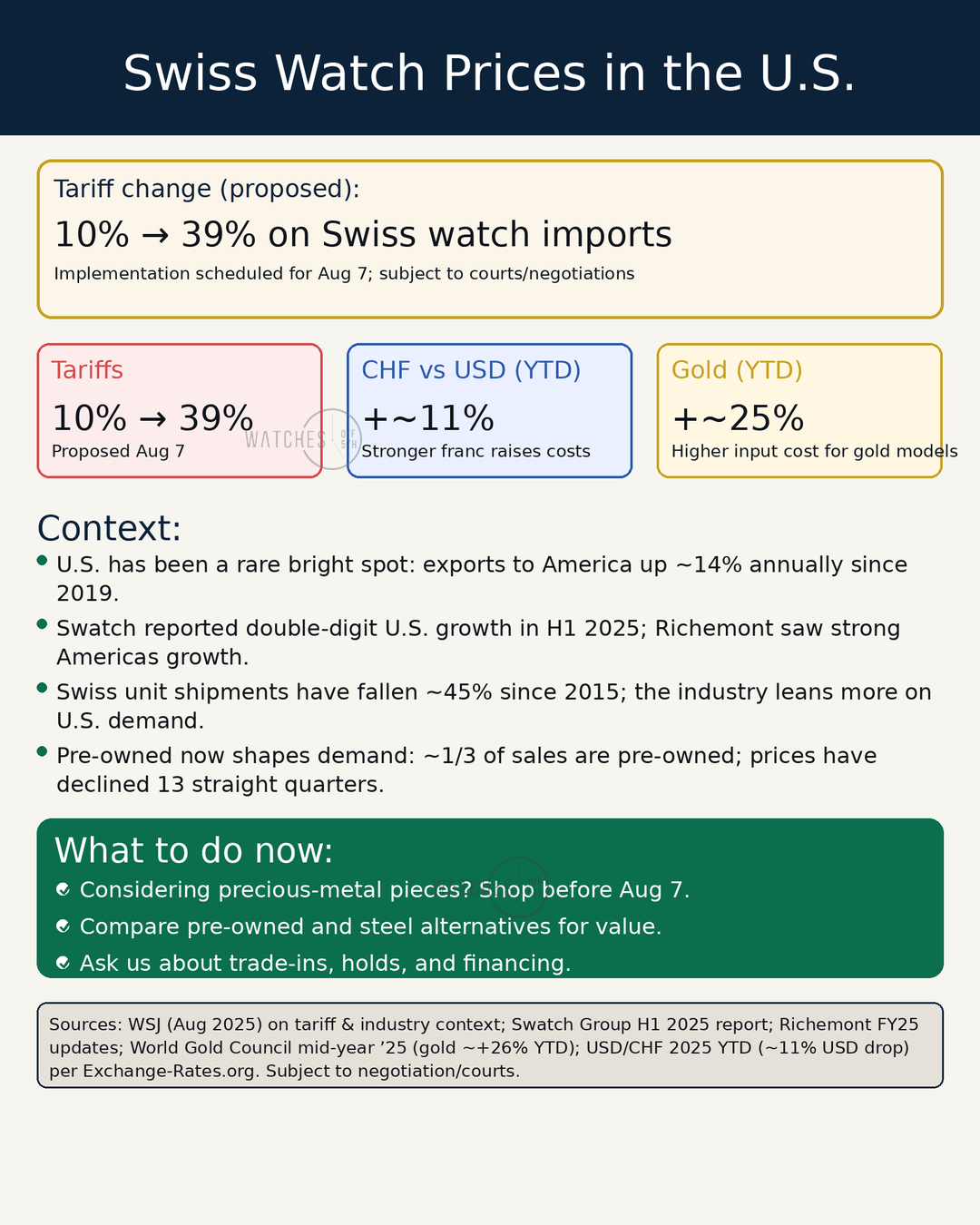Swiss Watch Prices in the U.S.: What to Know Before August 7
America has become the Swiss watch industry's most important growth market—and that's exactly why a policy change here matters. A new executive order raises tariffs on Swiss watch imports from 10% to 39% starting August 7, with the rate still subject to potential negotiation or court challenges. In plain English: brands will either absorb more cost or pass it through, and collectors should understand how this may affect pricing over the next few months. The Wall Street Journal
What exactly changed?
-
A 10% baseline tariff on imported Swiss watches has been in place since April.
-
The new order lifts the rate to 39% effective Aug 7 (implementation delayed until that date; policy could be modified or litigated). The Wall Street Journal
Why prices may rise: the "triple whammy"
-
Tariffs: 10% ➝ 39% on Swiss watch imports (proposed). The Wall Street Journal
-
Currency: The Swiss franc has strengthened ~11–12% vs. the U.S. dollar YTD, which raises Swiss-side costs when converted to USD. Exchange Rates
-
Gold: Gold is up ~26% YTD (mid-year)—especially relevant for precious-metal references. World Gold Council
Net effect: precious-metal pieces typically feel the pressure first (material + FX + tariff). Stainless-steel models can be affected as brands harmonize prices across ranges, but changes are usually smaller and more model-specific.
Why the U.S. market matters so much right now
-
The U.S. has been a rare bright spot: Swiss watch exports to America have shown strong growth, including ~8.6% in 2019. The Wall Street Journal
-
Swatch Group just reported double-digit growth in the U.S. across Omega, Longines, and others in 1H 2025. swatchgroup.com
-
Richemont's Specialist Watchmakers have shown strong growth in the Americas recently, including double-digit momentum in Q3. Moodie Davitt Report
At the same time, the industry has structural headwinds: unit shipments from Switzerland are down ~45% since 2015, with smartwatches and softer China demand in the mix. That has made the U.S. even more critical. The Wall Street Journal
New vs. pre-owned: why the secondary market now sets the tone
Roughly one-third of all global luxury watch sales are pre-owned, and used-watch prices have declined for 13 straight quarters. This larger, price-transparent secondary market can limit how far brands raise MSRP—because buyers can compare new prices to plentiful pre-owned comps in real time. The Wall Street Journal
Who is most exposed?
-
Precious-metal Rolex, Patek Philippe, AP, and other gold/platinum references (higher material + FX sensitivity).
-
New allocations that arrive after Aug 7 (imports facing the higher duty).
-
Mid-tier price points may feel more demand elasticity than ultra-high-end, where scarcity and collecting drive purchase behavior.
What savvy U.S. collectors can do now
-
If you're considering a precious-metal piece, shop before Aug 7 or ask about holding options so the current pricing applies to your purchase.
-
Compare pre-owned and steel alternatives for value; the secondary market may be the better entry point for certain references right now.
-
Trade-ins can offset price moves; we'll give you side-by-side options.
-
Thinking of buying abroad? Remember that U.S. duty/tariffs may still apply on return, and brands often harmonize pricing globally.
Our take (Watches Off 5th)
We'll keep this practical and transparent. Talk to us about timing, allocation, and reference-specific trends—and we'll help you evaluate new vs. pre-owned, precious metal vs. steel, and potential trade-in paths that fit your collection plan.
As of August 1, 2025. Tariff policy and timelines can change; we'll update clients if the legal or negotiation picture shifts. Sources: WSJ; Swatch Group 1H 2025; Richemont updates; World Gold Council mid-year 2025; USD/CHF YTD.


